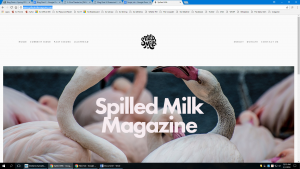Like many others in the class, I have some artsy literary leanings, and would like to focus my study on a lit mag website. I feel like this is an interesting way to go about examining rhetoric and design because each lit mag is so individual and unique to itself, and thus so are many of their websites. They seek to bring their diversity out in the subtle and less subtle choices they make to represent themselves to the entirety of the internet.
The link I have provided is to an online-only literary magazine, Spilled Milk:
http://www.spilledmilkmagazine.com/
I feel like it’s important to consider the diversity of an audience when designing/structuring/examining a webpage (so, in this case, examining the Spilled Milk homepage). Diversity in the traditional sense, of course (gender, sex, race, ethnicity, etc.), but also the diversity of readership, skill, lifestyle, and opinion. Some of the readers, for example, may not be writers, but may be investigating an interest in the literary community, still shy and unsure of their placement within it. Or, it may be a younger writer, self-conscious about their desire to be in the community and whether or not they have earned it and deserve to be there.
Of course, these are only two examples, but in general I am trying to emphasize the presence of less noticed or acknowledged audience members.
Writer/Designer says, “As readers, we can choose whether to act based on how effectively a text persuades us,” (35). To bring it back to the grocery store sign example from chapter one of Writer/Designer, the reason all of the lit mag websites were created were relatively the same, yet the design choices made and the strategic rhetoric used can make all the different in a media’s appeal to a reader.
I am no connoisseur of design (though this course is opening my eyes), but I would peg this website as having a fairly minimalist design. Its minimalist approach appeals to the senses of writers who are tired of the mainstream and the inundation of mainstream poetics and prose, but also potentially to those who don’t have a confidence in their presence in a literary community.

I agree with Cara and Sarah that there is a subtle beauty to a minimalist approach. Some might argue that a minimalist approach might hinder rhetoric, but I disagree. For certain audiences, such as some of those discussed above, the minimalist approach can be less confusing and less intimidating, and thus more successful at bringing in new readers, since the old readers, or the traditionally artistic, may already be drawn in as repeat media consumers by the content, and thus are less concerned with the aesthetic of the homepage of the website. This is especially true for cases where a website may be the first introduction a new consumer has to a more prominently in-print literary magazine.
Word count: 478
Works Cited
Ball, Cheryl E., Sheppard, Jennifer, and Arola, Kristin L. Writer/Designer.